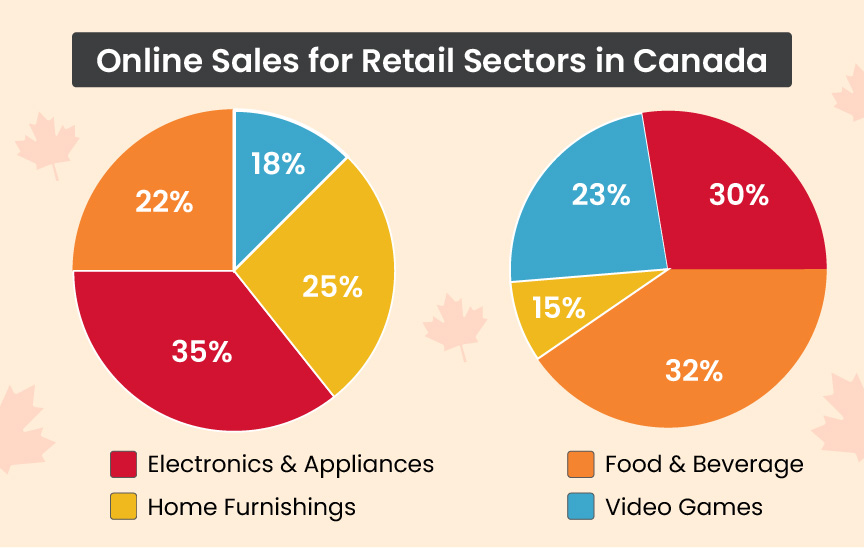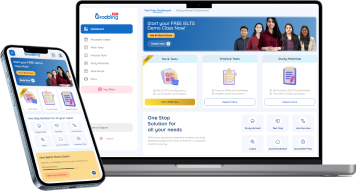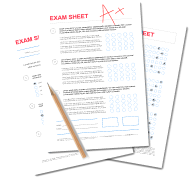The IELTS writing task is often considered the most challenging part of the entire exam for several reasons. One of the major factor contributing to this challenge is the pie chart task 1, which is a common question in the IELTS writing section. Therefore, carefully analyzing and describing the pie chart will help you ace this task of the exam. Thus, this blog aims to provide guidance on how to ace the pie chart task 1 of the test to reduce your worries. Let's start with having an overview of this in the upcoming section of the blog.

Table of Contents
In the IELTS writing task of the academic module, you are expected to describe visual data or information. The visual might be a pie chart, bar graph, diagram or diagrams. This blog aims at pie charts, a circle chart that is divided into pie slices, which are the sectors. These charts usually illustrate the percentages of something. Hence, the pie chart represents various segments with several categories. The size of each segment reflects its proportion as a whole. Thus, your task is to summarise the information presented in the chart and make the relevant comparison wherever needed.
Moreover, make sure to organize your answers properly and that the flow is not broken. The steps to a good answer are given in the next section.
In this section, we’ve compiled a selection of Pie Chart Task 1 Samples & Answers to help you understand how to effectively structure your response. Explore the samples below for a better understanding.

Pie Chart Sample 1 Answer
The pie chart shows the percentage of greenhouse gases emitted by various activities, such as electricity, transportation, different industries, and commercial and residential activities. Moreover, agriculture makes a minute contribution to the emission of these gases.
The general trend of the pie chart shows the maximum greenhouse gases released during electricity generation.
Agriculture tops the list of factors that contribute the least greenhouse gas emissions. It only contributes 9% of the total gas emissions. On the other hand, commercial and residential activities like using fridges and air conditioners contribute 12%. Moreover, various industrial activities emit 21% of these harmful gases.
In contrast, the main reason that releases these gases are several modes of transport, which exude 21% of the greenhouse gases. The maximum is secreted by electricity generation, which contributes 30% to nature.

Pie Chart Sample 2 Answer
The given pie charts illustrate the percentage of various sources of energy which were produced between 1995 and 2005.
Overall, it can be observed that most of the energy production had seen an exponential increase with petrol as an exception. Moreover, it can be noted that coal saw the highest trend in the decade, becoming the main energy source used by people.
The two sources of energy occupies more than half of the total pie charts in the period. About coal, it increased slightly from 29.80% to 30.93% between 1995 and 2005. Meanwhile, gas production rose gradually over time, reaching nearly 30% in the second year.
Taking a look at the alternate energy productions, nuclear and others increased nearly 5% from 64% to 10.1% and 4.9% to 9.1%, respectively. Likewise, in comparison with the others, petrol was the only energy production which saw a decrease.

Pie Chart Sample 3 Answer
The three pie charts illustrate the amount of money a particular UK school spent annually for the years 1981, 1991, and 2001.
As per the pie chart, the salaries of the teachers had the highest percentage for both years while insurance accounted for the smallest percentage of money spent by the UK school in all of the three selected years.
A school spent 40% of the total spending amount on teachers’ salaries in 1981 and it rose to 50% of the total amount in 1991. In 2001, the percentage slightly declined which was 45%. The spending on other workers’ salaries dropped gradually from 1981 to 2001. In the beginning, it was 28% in 1981, decreased to 22% in 1991 and in 2001, it dropped to 15% eventually.
The money spent on furniture and equipment and resources such as books was similar in 1981, which was 15% of the total amount. In 1991, a lot of money was spent on resources rather than furniture and equipment, 20% and 5% respectively, but it reversed in the year 2001. 23% of the money was spent on buying furniture and equipment while 9% of the amount was spent on resources like books. The amount spent on insurance gradually increased from the year 1981 to 2001. In 1981, a small proportion of money was allocated for insurance. It was 2%, rose to 3% in 1991 and 8% in 2001.

Pie Chart Sample 4 Answer
This pie chart for IELTS shows the amount of revenue and spending in 2016 for a children’s charity in the USA. Thus, it can be observed that donated food is considered the majority of income, while the program services are regarded as the most expenditure. Total revenue sources just surpassed the outgoings.
In detail, the donated food provided most of the income for the charity, at 86%. Similarly, about expenses, one category, program services, viewed for nearly all of the outgoings, at 95.8%
Other categories were much smaller. Community contributions, which was the second largest income-generating source, brought in 10.4% of the overall income, and this was followed up by the program revenue, at 2.2%. Investment income, government grants, and other income were very small sources of income, totalling only 0.8% combined.
There were two other expenditure items, fundraising and management and general, which for 2.6% and 1.6% respectively. The total amount of income was $53,561,580 which was sufficient enough to cover the expenses of $53,224,896.

Pie Chart Sample 5 Answer
The above given two pie charts compare the percentage of online sales around the various retail sectors in Canada in two different years, 2005 and 2010.
Overall, the online sales of electronic items and home furnishing fell, however, the craze for food and video games increased during the five years.
Beginning with 2005, the majority of online sales for the electronics and appliances sector is at 35%, this percentage has dropped to 30% by 2010. During the five years, the number of people deciding to buy food and beverages increased online and the deal went from just 22% to 32%, which makes the retail sector the largest proportion of the online market.
In 2005, the home furnishing industry boasted an impressive 25% of the total online sales in Canada. In addition, by 2010, this figure had fallen to 15%. Interestingly, the online sales of video games generally overtook the sales of home furnishing, despite video games still represented only 23% of the market.
In this section, there are five easy steps you can follow in order to write the answers to get the desired band score. Before moving to the steps, let us know about an ideal answer to the IELTS pie chart task 1 must contain four paragraphs which are as follows:
Now comes the steps to write a good answer.
Although the format of every question type in the IELTS writing task of the academic exam is the same, it is crucial for the candidate to understand the question properly. Every question contains the diagram brief and the instructions, The diagram can be a chart, graph, or table.
Always remember that the pie chart IELTS task 1 is meant to determine your language skills, not your mathematical ability. If you are confused about what to write. Ask the following question to yourself.
The first sentence must be the paraphrased version of the question so you achieve the task achievement. On the other hand, the second sentence must have three things: The main feature, its description, and comparison (if applicable).
In the second paragraph, you should report the identified main features which give only the general information. The details will be further mentioned in the flow of the essay.
Till now, you have known the first two paragraphs of writing task 1 pie chart task. The last two paragraphs will include the details of the main identified features. In paragraph 3, you should give evidence to support your first key feature. Don’t forget to make comparisons where relevant.
So, to complete pie chart IELTS task 1, you need to write the last paragraph which will have the second key feature concluding your part 1 of the IELTS writing task.
Every section is marked on a few criteria. The presence of each factor is crucial as they directly impact your band score. These are as follows:
These are the four factors that directly impact your IELTS band score. Each of them contributes equally. Always remember these factors and include things in the answer as per the task requirement. In the next section, let us know some tips to get better scores in writing task 1 pie chart task.
After knowing everything about the IELTS pie chart task 1 from the steps of writing a good answer to sample answers, here are a few expert tips.
It is crucial to understand the given requirement in task one of the writing section. Analyze the question, and start thinking of the points to include.
Drafting the answer before writing it down in the answer sheet becomes an important step. You can note down the key features to include in the answer. Also, you can bifurcate the keywords and phrases paragraph-wise to meet the requirement and complete the task in the time you allotted for yourself.
There are many complexities you may face while writing your answer for this task. It is vital to know the IELTS syllabus for the writing section to avoid any surprises. You can sign up for our FREE IELTS MOCK TEST to practice everything before attempting the official IELTS exam.
The writing task of the IELTS Academic lasts for 60 minutes. So, the test taker has to manage the time accordingly so they don’t miss out on the second task. Also, it is advisable that a candidate should spend only 20 minutes in the task one including the time to proofread so they have enough time to attempt the second task. Moreover, knowing IELTS exam pattern would help the candidate to segregate time carefully.
The appearing candidate can sign up for online IELTS coaching to strengthen the preparation of the language proficiency test and ace it on the first attempt. The experts will make you familiar with many things like IELTS exam eligibility, pattern, and syllabus. It will help you to be familiar with the real IELTS exam and the key factors to keep in mind.
These were the expert tips that will help you ace the test in the first attempt. In conclusion, you got to know about the IELTS writing section, the sample answers along with factors affecting band score and the steps of an ideal answer to get the desired band score.


98% students got exact IELTS Band
What is your Target IELTS Band?
Get familiar with the Real IELTS Exam for Free!
Start free Mock TestWe are available in :
BangaloreAhmedabadJaipurHyderabadKeralaPuneChandigarhMumbaiGurgaonChennaiKolkataTrivandrumNoidaKochiCalicutKottayamKollamThrissurIndoreUdaipurdisclaimer:logos and other registered trademarks of universities used on this platform are held by their respective owners. Gradding does not claim ownership or association on them, and their use is purely for informational and illustrative purposes.

 Take Writing Mock Test Now!
Take Writing Mock Test Now! 
